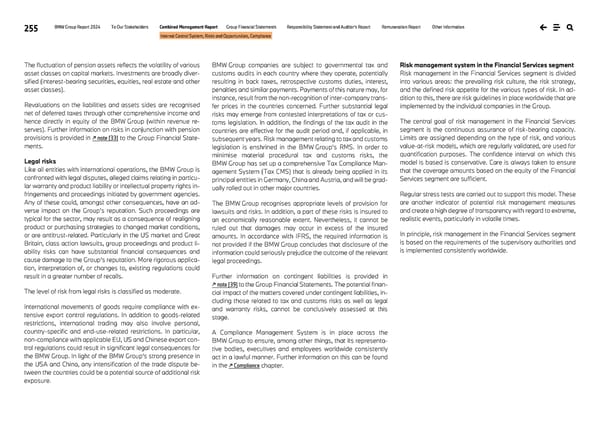255 BMW Group Report 2024 To Our Stakeholders Combined Management Report Group Financial Statements Responsibility Statement and Auditor’s Report Remuneration Report Other Information Internal Control System, Risks and Opportunities, Compliance The fluctuation of pension assets reflects the volatility of various asset classes on capital markets. Investments are broadly diver- sified (interest-bearing securities, equities, real estate and other asset classes). Revaluations on the liabilities and assets sides are recognised net of deferred taxes through other comprehensive income and hence directly in equity of the BMW Group (within revenue re- serves). Further information on risks in conjunction with pension provisions is provided in ↗ note [33] to the Group Financial State- ments. Legal risks Like all entities with international operations, the BMW Group is confronted with legal disputes, alleged claims relating in particu- lar warranty and product liability or intellectual property rights in- fringements and proceedings initiated by government agencies. Any of these could, amongst other consequences, have an ad- verse impact on the Group’s reputation. Such proceedings are typical for the sector, may result as a consequence of realigning product or purchasing strategies to changed market conditions, or are antitrust-related. Particularly in the US market and Great Britain, class action lawsuits, group proceedings and product li- ability risks can have substantial financial consequences and cause damage to the Group’s reputation. More rigorous applica- tion, interpretation of, or changes to, existing regulations could result in a greater number of recalls. The level of risk from legal risks is classified as moderate. International movements of goods require compliance with ex- tensive export control regulations. In addition to goods-related restrictions, international trading may also involve personal, country-specific and end-use-related restrictions. In particular, non-compliance with applicable EU, US and Chinese export con- trol regulations could result in significant legal consequences for the BMW Group. In light of the BMW Group’s strong presence in the USA and China, any intensification of the trade dispute be- tween the countries could be a potential source of additional risk exposure. BMW Group companies are subject to governmental tax and customs audits in each country where they operate, potentially resulting in back taxes, retrospective customs duties, interest, penalties and similar payments. Payments of this nature may, for instance, result from the non-recognition of inter-company trans- fer prices in the countries concerned. Further substantial legal risks may emerge from contested interpretations of tax or cus- toms legislation. In addition, the findings of the tax audit in the countries are effective for the audit period and, if applicable, in subsequent years. Risk management relating to tax and customs legislation is enshrined in the BMW Group’s RMS. In order to minimise material procedural tax and customs risks, the BMW Group has set up a comprehensive Tax Compliance Man- agement System (Tax CMS) that is already being applied in its principal entities in Germany, China and Austria, and will be grad- ually rolled out in other major countries. The BMW Group recognises appropriate levels of provision for lawsuits and risks. In addition, a part of these risks is insured to an economically reasonable extent. Nevertheless, it cannot be ruled out that damages may occur in excess of the insured amounts. In accordance with IFRS, the required information is not provided if the BMW Group concludes that disclosure of the information could seriously prejudice the outcome of the relevant legal proceedings. Further information on contingent liabilities is provided in ↗ note [39] to the Group Financial Statements. The potential finan- cial impact of the matters covered under contingent liabilities, in- cluding those related to tax and customs risks as well as legal and warranty risks, cannot be conclusively assessed at this stage. A Compliance Management System is in place across the BMW Group to ensure, among other things, that its representa- tive bodies, executives and employees worldwide consistently act in a lawful manner. Further information on this can be found in the ↗ Compliance chapter. Risk management system in the Financial Services segment Risk management in the Financial Services segment is divided into various areas: the prevailing risk culture, the risk strategy, and the defined risk appetite for the various types of risk. In ad- dition to this, there are risk guidelines in place worldwide that are implemented by the individual companies in the Group. The central goal of risk management in the Financial Services segment is the continuous assurance of risk-bearing capacity. Limits are assigned depending on the type of risk, and various value-at-risk models, which are regularly validated, are used for quantification purposes. The confidence interval on which this model is based is conservative. Care is always taken to ensure that the coverage amounts based on the equity of the Financial Services segment are sufficient. Regular stress tests are carried out to support this model. These are another indicator of potential risk management measures and create a high degree of transparency with regard to extreme, realistic events, particularly in volatile times. In principle, risk management in the Financial Services segment is based on the requirements of the supervisory authorities and is implemented consistently worldwide.
 BMW Group Report 2024 Page 254 Page 256
BMW Group Report 2024 Page 254 Page 256